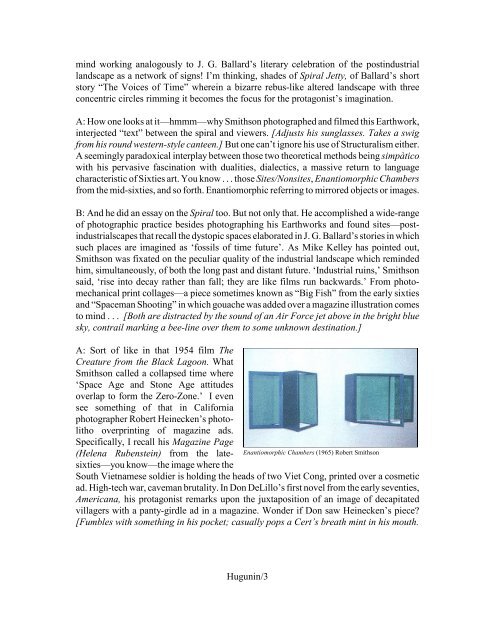It's Art, But Is It Photography? Robert Smithson's - Uturn.org
It's Art, But Is It Photography? Robert Smithson's - Uturn.org
It's Art, But Is It Photography? Robert Smithson's - Uturn.org
You also want an ePaper? Increase the reach of your titles
YUMPU automatically turns print PDFs into web optimized ePapers that Google loves.
mind working analogously to J. G. Ballard’s literary celebration of the postindustrial<br />
landscape as a network of signs! I’m thinking, shades of Spiral Jetty, of Ballard’s short<br />
story “The Voices of Time” wherein a bizarre rebus-like altered landscape with three<br />
concentric circles rimming it becomes the focus for the protagonist’s imagination.<br />
A: How one looks at it—hmmm—why Smithson photographed and filmed this Earthwork,<br />
interjected “text” between the spiral and viewers. [Adjusts his sunglasses. Takes a swig<br />
from his round western-style canteen.] <strong>But</strong> one can’t ignore his use of Structuralism either.<br />
A seemingly paradoxical interplay between those two theoretical methods being simpàtico<br />
with his pervasive fascination with dualities, dialectics, a massive return to language<br />
characteristic of Sixties art. You know . . . those Sites/Nonsites, Enantiomorphic Chambers<br />
from the mid-sixties, and so forth. Enantiomorphic referring to mirrored objects or images.<br />
B: And he did an essay on the Spiral too. <strong>But</strong> not only that. He accomplished a wide-range<br />
of photographic practice besides photographing his Earthworks and found sites—postindustrialscapes<br />
that recall the dystopic spaces elaborated in J. G. Ballard’s stories in which<br />
such places are imagined as ‘fossils of time future’. As Mike Kelley has pointed out,<br />
Smithson was fixated on the peculiar quality of the industrial landscape which reminded<br />
him, simultaneously, of both the long past and distant future. ‘Industrial ruins,’ Smithson<br />
said, ‘rise into decay rather than fall; they are like films run backwards.’ From photomechanical<br />
print collages—a piece sometimes known as “Big Fish” from the early sixties<br />
and “Spaceman Shooting” in which gouache was added over a magazine illustration comes<br />
to mind . . . [Both are distracted by the sound of an Air Force jet above in the bright blue<br />
sky, contrail marking a bee-line over them to some unknown destination.]<br />
A: Sort of like in that 1954 film The<br />
Creature from the Black Lagoon. What<br />
Smithson called a collapsed time where<br />
‘Space Age and Stone Age attitudes<br />
overlap to form the Zero-Zone.’ I even<br />
see something of that in California<br />
photographer <strong>Robert</strong> Heinecken’s photolitho<br />
overprinting of magazine ads.<br />
Specifically, I recall his Magazine Page<br />
(Helena Rubenstein) from the late- Enantiomorphic Chambers (1965) <strong>Robert</strong> Smithson<br />
sixties—you know—the image where the<br />
South Vietnamese soldier is holding the heads of two Viet Cong, printed over a cosmetic<br />
ad. High-tech war, caveman brutality. In Don DeLillo’s first novel from the early seventies,<br />
Americana, his protagonist remarks upon the juxtaposition of an image of decapitated<br />
villagers with a panty-girdle ad in a magazine. Wonder if Don saw Heinecken’s piece?<br />
[Fumbles with something in his pocket; casually pops a Cert’s breath mint in his mouth.<br />
Hugunin/3


